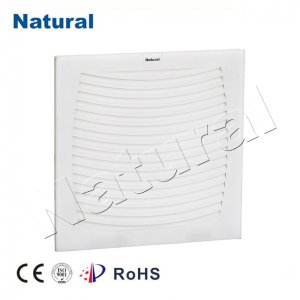In our modern lives, where we spend the majority of our time indoors, the quality of the air we breathe plays a significant role in our overall well-being. Indoor air pollution can be a serious concern, but thankfully, there are solutions available to address this issue. One such solution is the ventilation fan filter, a device designed to improve indoor air quality by effectively removing pollutants and allergens from the air.

Ventilation fan filters are essential components of HVAC (Heating, Ventilation, and Air Conditioning) systems in both residential and commercial buildings. Their primary purpose is to ensure that the air circulated within the indoor spaces is clean, fresh, and free from various contaminants that can pose health risks. These filters work by capturing particles such as dust, pet dander, pollen, smoke, and even microorganisms, preventing them from recirculating and spreading throughout the building. The importance of ventilation fan filters becomes evident when we consider the potential health consequences of poor indoor air quality. Allergies, asthma, respiratory infections, and other health issues can be exacerbated or even caused by exposure to indoor pollutants. By incorporating efficient filters into the ventilation system, occupants can significantly reduce their exposure to these harmful substances.
There are several types of ventilation fan filters available, each with its own level of filtration efficiency and suitability for different environments. Here are a few common types:
Mechanical Filters:These are the most common type of filters and work by physically trapping particles as air passes through. They are further categorized into subtypes such as High Efficiency Particulate Air (HEPA) filters, which can capture particles as small as 0.3 microns in size, including many allergens and some bacteria.
Activated Carbon Filters:These filters are particularly effective at removing odors, chemicals, and volatile organic compounds (VOCs) from the air. Activated carbon has a porous structure that adsorbs these substances, preventing them from being recirculated.
Electrostatic Filters:These filters use an electrostatic charge to attract and trap particles. They are efficient at capturing smaller particles and can be washable and reusable.
UV-C Filters:These filters use ultraviolet (UV) light to kill or inactivate microorganisms like bacteria and viruses. They are often used in conjunction with other filter types for enhanced protection.
The choice of ventilation fan filter depends on factors such as the specific pollutants present in the indoor environment, the required level of filtration, and maintenance considerations. Regular maintenance, including cleaning or replacing filters as recommended by the manufacturer, is crucial to ensure that the filters continue to operate effectively.
In addition to improving indoor air quality, ventilation fan filters also contribute to energy efficiency. A well-maintained HVAC system with clean filters operates more efficiently, leading to lower energy consumption and reduced utility bills. This dual benefit of cleaner air and energy savings makes ventilation fan filters a wise investment for any building.
In conclusion, the importance of ventilation fan filters cannot be overstated when it comes to creating a healthy indoor environment. These filters play a vital role in removing pollutants, allergens, and microorganisms from the air, thereby reducing the risk of respiratory problems and other health issues. With various types of filters available, tailored solutions can be chosen based on the specific needs of different spaces. By incorporating ventilation fan filters into HVAC systems and maintaining them properly, we can breathe easier and enjoy the benefits of both improved air quality and energy efficiency.
 28 items Patent
28 items Patent
 28 items Patent
28 items Patent
 28 items Patent
28 items Patent

